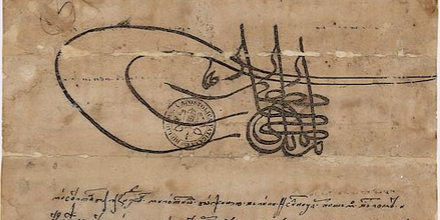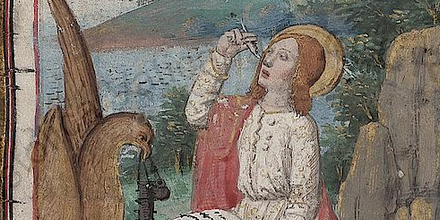Since I do not read Arabic -- apart from having a rusty ability, obtained in journalism work 30 years ago, to transliterate from the script -- I will rely here on notes provided at Rome Reborn, an exhibition of Vatican manuscripts in 1992 at the US Library of Congress in Washington.
One of the great treasures highlighted at that show was the Memoir on Astronomy or Tadhkira fi'ilm al'haya written by Nasir ad-Din at-Tusi, who was among the first of several Arabic-language astronomers who modified Ptolemy's models based on mechanical principles in order to preserve the uniform rotation of spheres.
The Vatican has a 14th-century Arabic manuscript of it, Vat. ar. 319. The Rome Reborn exhibition notes (online at the St. Louis University Library) say that the figure above is his ingenious device for generating rectilinear motion along the diameter of the outer circle from two circular motions. In simple terms: the black dot goes up and down only.
This page, now digitized, to be zoomed in and enjoyed, is 28v. There is some biographical data on the astronomer at Musicologie.org.in French, and an extensive discussion of Tusi's discoveries in Frederick Starr's Lost Enlightenment, published 2013 and partly readable on Google Books.
Should you be wondering why the opening shown at Rome Reborn, fols. 29 recto and 28 verso, seems to be in backwards order, blame a long-ago Vatican librarian. Most of the BAV manuscripts seem to be numbered next-page-to-the-right regardless of language, though most oriental manuscripts are read right to left and turned next page to the left.
Vat. ar. 319 has been online for some time, and is not one of the newest batch, but it makes a suitable introduction to the May 26 uploads at Digita Vaticana comprising 14 manuscripts, all non-Latin. With their publication on the portal, the front-page total rises to 2,022. (Since reduced to 2,019, seemingly by withdrawing Ott.gr.326 and by consolidating duplicates.)
- Barb.or.104, poem Timurmaneh by Persian poet Hatifi (died 1522)
- Borg.ebr.11
- Vat.ar.1411
- Vat.ar.1551
- Vat.ar.1614
- Vat.pers.12
- Vat.pers.76
- Vat.pers.155
- Vat.turc.214
- Vat.turc.316
- Vat.turc.420
- Vat.turc.430, contains a story of the "Muslim" Jesus (also known as Prophet Isa) according to a Turkish tradition. For a translation to English (large PDF!), see a 2011 article by Delio V. Proverbio.
- Vat.turc.432
- Vat.turc.433












